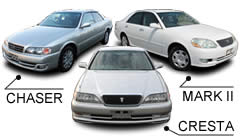Comparing The Toyota Chaser, Cresta And Mark II - Vol.182
In 1980, the Toyota company released a four-door sedan under the name "Cresta." The Cresta chassis was also used on several other cars in the Toyota line, including the Toyota Chaser and the Toyota Mark II as well as the Toyota Cressida, which was released in the American market and became Toyota's flagship offering in the United States.

The practice of sharing a chassis design across several different names of automobiles is nothing new for the automobile industry. Using the same basic mechanical design while creating different exteriors designs to differentiate several different cars is known as "platform sharing." It is a practice that helps manufacturers keep costs low; essentially, they do not have to plan, design and implement a new chassis for each of the different cars that they produce. If something works well, there is no need to waste time reinventing the wheel.
Though it used the same chassis for the construction of the Cresta, the Chaser and the Mark II (as well as the Cressida), the intended final products for the three different cars was expected to appeal to different types of buyers. The Cresta was designed to serve as a basic sedan to serve as a family car or simply to act as a car to get a driver from one place to another. There was nothing flashy or special about the Cresta or its design. It was simply designed to be a reliable, well-built sedan for everyday use.
The Chaser, however, was designed with an eye toward a sportier car. Even the name "Chaser" was intended to give the feel of something that had a more aggressive, faster feel to it. As such, the exterior design was given a look that resembled a sports car more than either of the other two offerings built from the Cresta chassis. The headlights and tail lights are the most obvious differences when it comes to the external design of the Chaser. With the slight alterations in the lights on both the front and the rear of the cars, the bumpers and fenders also had some slight cosmetic variations.
The Mark II, on the other hand, was intended to be a luxury sedan. The car was designed with an external appearance that would appeal to a more high-end buyer. Though built from the same chassis as the other two, the Mark II was given a look that tried to appear more sophisticated while also conveying a sense of reliability and style. In essence, the Mark II was supposed to be the pretty car, the Chaser the cool car, and the Cresta was intended to be the reliable and "safe" car.
Beyond the external designs, the interior designs of the three cars also reflected their intended audience. Depending on the style, the interiors offered different functionalities or "extras" that are included in the cars. Again, many of these changes were cosmetic in nature.
While a few of the external parts looked different, the chassis remained unchanged. By using the same chassis for all three cars, much of the internal workings of the cars were exactly the same. All of the cars were designed with rear-wheel drives and they were all designed to use automatic transmissions. The engines sometimes offered some slight variations, depending on which automobile its intended destination was. The suspensions and the undercarriage were also highly conserved across the three different models.
When it comes down to it, the only real difference in the cars is the look. When shopping and comparing between a Cresta, Chaser and Mark II, the buyer's own personal preferences will be the main difference when choosing. Not even price is much of a determining factor as all three cars, whether sporty or sophisticated, were very similarly priced.